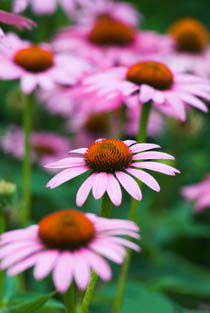
Going back to school is an exciting time for both children and parents. Unfortunately, your child will be exposed to more than just history and geometry. In fact, trying to stave off seasonal sniffles is like undergoing hand-to-hand combat with an invisible force—with the germs usually coming out ahead. But, with echinacea on your side, you can win the battle.
Echinacea is a member of the daisy family (Asteraceae) of flowering plants that are native to North America. There are nine species of echinacea, but Echinacea purpurea, E. angustifolia and E. palida are considered the species with the most potent medicinal properties. The root of the genus name, “echino,” is taken from the Greek to mean “spiny” or “hedgehog,” an apparent reference to the prickly spikes that reside in the center of the seed heads. However, most people are more familiar with the herb’s common name of purple coneflower, which pays tribute to the color and conical shape of the flowers.
Historically, echinacea has held a place in medicine for centuries. Several North American Plains tribes used this herb for at least 400 years to address many ailments. The Kiowa Tribe of Oklahoma, for instance, used echinacea to treat cough and sore throat, while the Sioux and Pawnee used it to relieve pain. As with many other herbs, natives learned of the health-giving benefits of echinacea by observing the behavior of animals. According to Gregory L. Tilford, author of “Edible and Medicinal Plants of the West,” the Indians frequently noticed that elk would seek out these plants when injured or sick. Perhaps this is why some texts refer to the plant as elk root.
Echinacea was an important remedy used by the Eclectic physicians, who dominated American medicine in the late 19th and early 20th century. Here, too, the herb was used to address pain, as well as to counter anthrax, malaria, scarlet fever, snakebite, syphilis, diphtheria and blood poisoning. Today, most people regard echinacea as an immune system stimulant, and one of the best herbal remedies to take at the first sign of a cold. However, this application of echinacea did not become popular in the U.S. or Europe until the 1930s. In addition to enhancing immune function, modern herbalists recommend oral doses of echinacea to treat urinary tract infections, candida yeast infections, allergic rhinitis, sinus and ear infections, athlete's foot and even recurrent herpes simplex type I infections. In Europe, the German E Commission has approved the use of E. purpurea leaf extracts to treat slow-healing wounds, urinary tract infections, colds and upper respiratory tract infections, while E. pallida root extracts are approved to treat influenza infections, otherwise known as the common flu. In the U.S., however, liquid extracts and other echinacea preparations may contain any of these species, or a combination of two or all three.
The pharmacological effects of echinacea are due to the presence of several phytochemicals, namely bioflavonoids, alkamides, glycoproteins and polysaccharides. Collectively, these agents stimulate lymph glands to produce and release more leukocytes, specialized white blood cells that seek out and destroy invading pathogens. Other scavenging white blood cells called macrophages also increase in number. This translates to more bacteria-digesting enzymes in circulation to target and neutralize hyaluronidase, the enzyme foreign microorganisms secrete to break down and penetrate the protective membranes of healthy cells, where they can take up residence and self-replicate.
In terms of clinical evidence of the herb’s effectiveness, study results are mixed. According to the National Center for Complementary and Alternative Medicine, a division of the National Institutes of Health, some studies using various echinacea extracts showed no effect on the common cold in children or adults, while other studies indicate the herb may be effective in treating upper respiratory infections. It should be noted, however, that many of these studies might be flawed due to using poor quality extracts. A review of echinacea products conducted by a well-known independent, third party laboratory called ConsumerLab.com, LLC revealed that only four out of 11 products tested actually contained what was stated on the label. In addition, the majority of the standardized preparations didn’t contain the same amount of active ingredients listed, and half contained a different species of echinacea than that listed on the label. Incredibly, 10% of the products tested didn’t contain any echinacea at all. The lesson learned from this study is to place your trust with a highly reputable source when purchasing herbal products. Of course, since you’re reading this, you already have.
The standard dose to enhance immune function in adults is 1-3 ml tincture, 2-3 ml liquid extract or 1-2 grams dried root or leaf, prepared as tea. All dosages should be taken 3 times per day, up to 10 days in succession. Most herbalists recommend a break of 10-15 days between supplementing sessions to maintain optimum effectiveness.
The above dosages are based on a 150-pound adult. To adjust the dosage for a child, go by the child’s weight. For instance, the dose for a 50-pound child would be one-third that of the standard adult dose.
Please note that people with HIV/AIDS or other autoimmune disease should not take echinacea, or anyone with a history of liver disease, connective tissue disorders, tuberculosis, multiple sclerosis, diabetes or leukemia. If you are an organ transplant recipient currently taking immunosuppressive medications, you should not use this herb. Echinacea may also interact with certain cancer medications. As with all drugs, do not take this herb if you are pregnant or nursing unless directed by a physician.
Disclaimer: This information has not been evaluated by the U.S. Food and Drug Administration and is not intended to diagnose, treat, cure, or prevent any disease.
